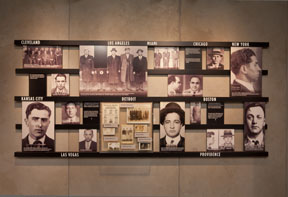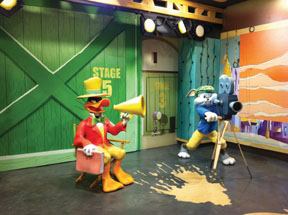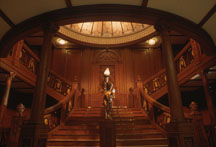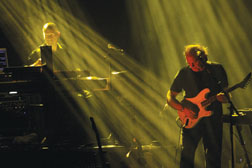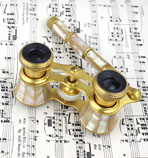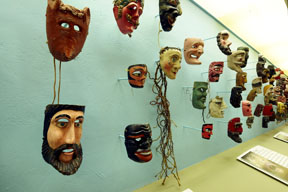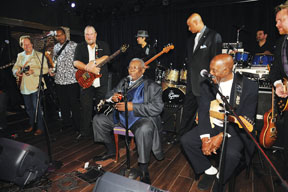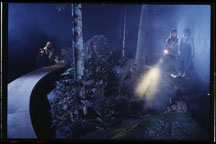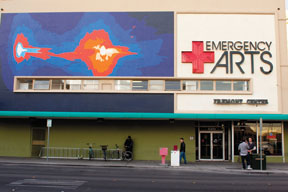Made in America – The Mob Museum
By Mike Sweeney
Wise guys and made guys have long formed an indelible part of the history of Las Vegas. While Martin Scorsese’s film Casino brought the stories of Frank “Lefty” Rosenthal and Tony “The Ant” Spilotro into the spotlight, the mob’s legacy in Sin City and throughout America goes back decades further. The newly opened National Museum of Organized Crime & Law Enforcement, better known as The Mob Museum, paints a vivid picture of the notorious gangsters and intrepid lawmen who clashed in a furious battle that forever changed the face of modern history.
Public Enemies
Housed in the former federal courthouse and U.S. Post Office building downtown, the museum offers an all inclusive chronicle of organized crime through three floors worth of photographs, films, historical artifacts and interactive exhibits. From the days of Prohibition to the glamour of Las Vegas and the modern era of media darlings such as John Gotti, the sordid tales of murder, corruption and criminal activity provide a fascinating window on American culture. Detailed accounts trace the mob’s involvement in racketeering, bootlegging, gambling, politics, prostitution and more, highlighting a widespread criminal enterprise with its hands in just about everything. As infamous gangster Meyer Lansky once said, “We’re bigger than U.S. Steel.”
Interactive exhibits such as touch screen panels provide an encyclopedia’s worth of information to read through and explore. This is one museum that encourages you to be hands on, whether it’s test firing a simulated Tommy gun with some real kick or taking a seat in the actual electric chair from Sing Sing prison, where Louis “Lepke” Buchalter of Murder, Inc. met his fate. Artifacts housed behind glass provide a tangible sense of history, from old ledgers and fingerprint records to weapons favored by merciless hit men to astounding features such as the barber chair where Albert Anastasia was killed and the actual murder wall from the St. Valentine’s Day Massacre, still riddled with bullet holes from Al Capone’s ruthless thugs.
On the Case
We also get a good picture of the battle from the other side of the line, where noble G-Men such as Eliot Ness and Harry Anslinger took the fight to the mob with dedicated efficiency. A major part of the exhibit focuses on hearings led by Senator Estes Kefauver that questioned key mob players about their part in organized crime. An entertaining film projected on three screens in the old courtroom brings the hearings to life with dramatic reenactments. The ground floor traces efforts of the Department of Justice and other police and governmental agencies to conduct surveillance, gather evidence and apprehend mob figures. Listen to wiretap recordings and learn about informants and undercover operatives such as FBI agent Joe Pistone (aka Donnie Brasco).
The House Always Wins
Naturally, the mob’s history in Las Vegas forms a big part of the museum. As Dean Martin plays in the background, you’ll find walls of photos recounting the glitz and glamour of old Vegas, tracing its rise from 1950s boomtown to the days of the Rat Pack and Howard Hughes, when forgotten hotels such as the El Rancho and Desert Inn were still hot properties. Here you’ll learn about the legendary “Black Book” that kept mobsters banned from casinos, battles with the Nevada Gaming Commission and how big time gangsters like Frank Costello profited by skimming money from major casinos such as the Tropicana. There’s even a display featuring mementos and court documents from defense attorney and former mayor Oscar Goodman.
While Las Vegas will always share a notorious connection with organized crime, The Mob Museum doesn’t seek to either embrace or condemn that legacy. Rather, it presents a detailed account from both sides of the law and allows visitors to form their own opinions. The result is an entertaining and educational experience that anyone with a passion for history can appreciate.
For more information on The Mob Museum, visit www.themobmuseum.org.
What’s Up, Doc? The Chuck Jones Experience
By Mike Sweeney
Even if you don’t know the name Chuck Jones, you’re probably still familiar with his work. Over the course of his distinguished 60-year career, he created over 300 animated films and helped bring to life some of the most beloved cartoon characters of all time, such as Daffy Duck, Porky Pig, Pepé Le Pew and that “wascally wabbit” himself, Bugs Bunny. Thanks to the new Chuck Jones Experience exhibit, which will hold its grand opening at Circus Circus on January 18th, Las Vegas residents can get an inside look at the life and career of this extraordinary artist.
Every aspect of the exhibit is designed to celebrate Jones’ brilliant work, including the Acme Warehouse gift shop and animation gallery found at the main entrance. Themed after the infamous mail order company from which Wile E. Coyote acquires his mediocre anvils and explosives, the store offers books and souvenirs of all kinds, including a display of artwork and framed animation cels. Once you’ve had a good look around, purchase your ticket and make your way inside a cartoon lover’s wonderland.
The first stop on the tour is Animation Alley, a painted street scene that’s bursting with color, where the walls display some vivid renderings of treasured characters and a timeline of Chuck’s life. Here you’ll also find the Chuck Jones Theatre, a small movie house designed to resemble the 1930s-style venue from Jones’ classic cartoon, One Froggy Evening. Take in the old-fashioned surroundings as you view a short film that serves as an introduction to Chuck’s world.
From there, your visit takes you to a physical recreation of his office at Warner Bros., where he worked among the famous “Termite Terrace” team of animators, whose ranks also included Tex Avery and Friz Freleng. You’ll get to see Chuck’s actual work desk, along with a few book cases stocked with items from his personal library. Everything from the tile floor to the period wainscoting evokes an old Hollywood milieu. The gallery that follows puts Jones’ work front and center. Alongside his drawings and sketches, you’ll discover an impressive display of accomplished oil paintings, both of his classic creations and other subjects from real life.
One of the best things about the Chuck Jones Experience is its interactivity. Stand beside 3-D models of his famous animated characters and see how you measure up. Engage in some Chuck Jones trivia with the amusing Quiz-a-Nator by moving tiles, spinning blocks and pulling levers. In the Universe of Animation room, inspired by Marvin the Martian, try your hand at creating your own cartoons using an old-fashioned spinning zoetrope device. You can even provide voice-over and live sound effects (known in the industry as “Foley”) for a classic cartoon at the Rikki-Tikki Foley Stage, a reference to the artist’s animated version of Rikki-Tikki-Tavi.
As you exit the exhibit, you’ll find the glass-enclosed Chuck Jones Center for Creativity classroom. Founded by Jones with the hope of inspiring joy and innovation in others, this nonprofit organization will offer drawing classes, lectures and various other projects and educational programs for children of all ages to explore their artistic side. Chuck believed that creativity was one of the strongest forces on the planet, and this facility serves to (pardon the expression) illustrate the fundamentals of his philosophy.
The Chuck Jones Experience brings a welcome addition of family-friendly entertainment to Las Vegas. There’s even a parking structure adjacent to the exhibit entrance, so you don’t have to walk through the casino to discover all the fun. Take a nostalgic trip back to the Golden Age of animation and experience the life, work and genius of a man who educated, inspired and entertained millions with his imaginative and amusing outlook on the world. As Chuck Jones himself once said, “The rules are simple. Take your work, but never yourself, seriously. Pour in the love and whatever skill you have, and it will come out.”
For more information, visit www.chuckjonesexperience.com.
A Century of Sunken Dreams – Titanic: The Artifact Exhibition
By Mike Sweeney
One hundred years ago, the RMS Titanic struck an iceberg on its maiden voyage from Southampton to New York City and sank to the bottom of the North Atlantic. Over 1,500 people perished that cold April night, the “ship of dreams” lost forever to history… or so we once thought. Thanks to decades of recovery and preservation efforts, visitors from around the world can relive the story of the doomed ocean liner at Titanic: The Artifact Exhibition, a collection of authentic artifacts and dramatic recreations of the voyage, now in its fifth year at the Luxor.
From moment one, the exhibit conveys a “you are there” quality. Each guest is handed a facsimile “boarding pass” that bears the name of a different real life passenger with facts about their journey aboard the ship. From there, proceed at your own pace through a chronological timeline of the vessel’s legacy, from her construction in the shipyards of Belfast to the ill-fated sinking. Enlarged photographs and archival film footage help bring the startling details to life, while informative placards throughout provide facts on passengers both celebrated and obscure.
All the relics on display were salvaged from the debris field around the Titanic. Nothing is taken from inside the wreckage as it’s considered a memorial grave site. Glass cases house everything from clothes and jewelry to navigational tools to an impressive display of restaurant place settings. Most items are remarkably well preserved, including a half full bottle of champagne and a collection of aromatic perfume samples. Currency from around the world gives a sense of the ocean liner’s diverse collection of passengers, emphasizing the global scope of the disaster.
Beyond the exceptional gathering of artifacts, the exhibit also includes recreations of certain parts of the ship that depict a vintage Edwardian atmosphere. Stroll along the Promenade Deck and feel the chill in the night air. Admire the famous Grand Staircase as elegant chamber music sets the scene. Study duplications of first and third class cabins to see how both the affluent and the less fortunate were able to share the journey. None of it may be real, but you can still feel the lingering ghosts of wealthy dowagers and steerage drifters alike calling out from the past.
One of the most breathtaking items on display is the “Big Piece,” a 15-ton chunk of Titanic’s starboard hull, the largest section of the ship ever recovered. Standing 26 feet long and 12 feet tall, this iron monolith towers over all who stand before it, yet an accompanying illustration shows that this was but a miniscule piece of the 883-foot-long hull. With rivets the size of tennis balls and steel plates that could crush an elephant, it’s easy to see where Titanic got its name.
At last, you come to the memorial wall at the end of the exhibit, a complete list of the ship’s passengers broken down by class – and also by who lived and who died. I check my boarding pass to find out that my alter ego did not survive, but his wife and son did. Small consolation for them, but it’s a sharp reminder of the human face of this calamity. For all its historical importance, the sinking of the Titanic changed many lives forever. Thanks to wonderful exhibits such as this one, we can still experience the profound impact of such an emotional tragedy.
For more information on special events surrounding the upcoming 100th anniversary of the sinking, visit www.luxor.com/entertainment/titanic.aspx.
Made in America – The Mob Museum
By
Mike Sweeney
Wise guys and made guys have long formed an indelible part of the history of Las Vegas. While Martin Scorsese’s film Casino brought the stories of Frank “Lefty” Rosenthal and Tony “The Ant” Spilotro into the spotlight, the mob’s legacy in Sin City and throughout America goes back decades further. The newly opened National Museum of Organized Crime & Law Enforcement, better known as The Mob Museum, paints a vivid picture of the notorious gangsters and intrepid lawmen who clashed in a furious battle that forever changed the face of modern history.
Public Enemies
Housed in the former federal courthouse and U.S. Post Office building downtown, the museum offers an all inclusive chronicle of organized crime through three floors worth of photographs, films, historical artifacts and interactive exhibits. From the days of Prohibition to the glamour of Las Vegas and the modern era of media darlings such as John Gotti, the sordid tales of murder, corruption and criminal activity provide a fascinating window on American culture. Detailed accounts trace the mob’s involvement in racketeering, bootlegging, gambling, politics, prostitution and more, highlighting a widespread criminal enterprise with its hands in just about everything. As infamous gangster Meyer Lansky once said, “We’re bigger than U.S. Steel.”
Interactive exhibits such as touch screen panels provide an encyclopedia’s worth of information to read through and explore. This is one museum that encourages you to be hands on, whether it’s test firing a simulated Tommy gun with some real kick or taking a seat in the actual electric chair from Sing Sing prison, where Louis “Lepke” Buchalter of Murder, Inc. met his fate. Artifacts housed behind glass provide a tangible sense of history, from old ledgers and fingerprint records to weapons favored by merciless hit men to astounding features such as the barber chair where Albert Anastasia was killed and the actual murder wall from the St. Valentine’s Day Massacre, still riddled with bullet holes from Al Capone’s ruthless thugs.
On the Case
We also get a good picture of the battle from the other side of the line, where noble G-Men such as Eliot Ness and Harry Anslinger took the fight to the mob with dedicated efficiency. A major part of the exhibit focuses on hearings led by Senator Estes Kefauver that questioned key mob players about their part in organized crime. An entertaining film projected on three screens in the old courtroom brings the hearings to life with dramatic reenactments. The ground floor traces efforts of the Department of Justice and other police and governmental agencies to conduct surveillance, gather evidence and apprehend mob figures. Listen to wiretap recordings and learn about informants and undercover operatives such as FBI agent Joe Pistone (aka Donnie Brasco).
The House Always Wins
Naturally, the mob’s history in Las Vegas forms a big part of the museum. As Dean Martin plays in the background, you’ll find walls of photos recounting the glitz and glamour of old Vegas, tracing its rise from 1950s boomtown to the days of the Rat Pack and Howard Hughes, when forgotten hotels such as the El Rancho and Desert Inn were still hot properties. Here you’ll learn about the legendary “Black Book” that kept mobsters banned from casinos, battles with the Nevada Gaming Commission and how big time gangsters like Frank Costello profited by skimming money from major casinos such as the Tropicana. There’s even a display featuring mementos and court documents from defense attorney and former mayor Oscar Goodman.
While Las Vegas will always share a notorious connection with organized crime, The Mob Museum doesn’t seek to either embrace or condemn that legacy. Rather, it presents a detailed account from both sides of the law and allows visitors to form their own opinions. The result is an entertaining and educational experience that anyone with a passion for history can appreciate.
For more information on The Mob Museum, visit www.themobmuseum.org.
Prelude to Drama in the Desert – The Smith Center for the Performing Arts
It’s official: come spring of 2012, Vegas will be Broadway-bound, and The Smith Center for the Performing Arts will make history as the city’s first state-of-the-art venue dedicated primarily to performance art. Subscriptions to the center’s first Broadway series, featuring The Color Purple, Mary Poppins, Million Dollar Quartet and Memphis, have been on sale since summer, but with the recent announcement of their Design Your Own series, audiences have so much more to cheer about.
Regards to Broadway…Hello DYO
Despite the city’s penchant for bringing big budget entertainment to the masses, the bright lights, drama and action of Broadway have been a long time coming. Yet, as wonderful as it is to have Broadway caliber shows grace the center’s stage, the Design Your Own series is perhaps the most exciting revelation for both avid theater goers and tepid fans alike. Traditionally, in places like New York where theater reigns supreme, DYO tickets are generally only sold within a specific genre, be it all dance or all music, and there isn’t much crossover. The Smith Center is breaking the mold with their own offerings, which gives guests the opportunity to sample genres that span from comedy to music to spoken word performances.
“We plan to bring the community a wide variety of shows in order to provide cultural diversity for all,” said Myron Martin, president and CEO of the Smith Center. “The Design Your Own series has something for everyone and will allow people to customize a package that fits their interests, while allowing them to explore new acts they may not have otherwise sought out.”
With more than 20 shows to choose from, the series offers visitors a taste of everything, including up to 15% savings on individual ticket prices. It breaks down like this: purchase tickets for three different shows, receive a 5% total discount; purchase five shows, receive a 10% discount; purchase seven shows, receive a 15% discount. Individual ticket prices for DYO productions start as low as $24, and by packaging three or more shows into a custom series, patrons can save even more.
What’s On
Titles available for the Design Your Own series are a blend of dance, music and special attractions featuring some of the best entertainment acts out there. The series kicks off with a performance by Bela Fleck and the Flecktones on March 12th. Fronted by master-banjoist Bela Fleck, this Grammy award-winning quartet covers it all from classical and jazz to bluegrass and electric blues, with a touch of Eastern European folk thrown in for good measure. The hits just keep on coming with performances that include Disney’s Imagination Movers, Alvin Ailey American Dance Theater, The Pink Floyd Experience, The Cleveland Orchestra and Yo-Yo Ma. Even David Sedaris, one of America’s preeminent humor writers, will take the stage to share his sardonic wit with audiences. Lily Tomlin will make an appearance on May 13th, followed by Buddy Guy with Quinn Sullivan on May 19th.
Indeed, there is something here for everyone’s enjoyment. And from the looks of it, The Smith Center for the Performing Arts will make a renowned cultural destination out of Vegas yet! Purchase tickets and scout out shows at www.thesmithcenter.com.
A Night at the Opera – Tosca in Las Vegas
by Chad Felix
Let’s be honest; we haven’t exactly been fair to the opera. The form, once a hugely popular and respected means of art and entertainment, has fallen out of favor in our time. The question is “why?” Is opera obsolete? Should it just be left to those late-night public broadcast specials and the dusty bins of used record stores? Well, no and no. Contrary to popular belief, opera is not intended for a select few, nor is it some lumbering relic of yesteryear. It is, rather, a timeless expression of the human spirit through song, accompaniment and drama; a veritable tour de force of emotion to be enjoyed by all. But none of this means anything until you experience it first-hand.
Maestro, bring on Opera Las Vegas, our city’s foremost purveyors of the operatic arts. Established back in 1999, the nonprofit has been putting on productions for the Las Vegas Valley for over a decade now and shows no signs of stopping. If anything, they are speeding up. Under the guidance of the newly appointed artistic director Gloria Marinacci Allen, who has herself acted in nearly sixty musical theatre and operatic roles, the entity is preparing to tackle their first ever complete season for 2011-12, featuring three world-class productions: Tosca, The Barber of Seville and Carmen.
The Season Begins
First up is Tosca (1900). Come September, Opera Las Vegas will produce the work that is, according to a poll of the American people, among the ten best loved operas. It’s no surprise. Written by Giacomo Puccini with some help from librettists Luigi Illica and Giuseppe Giacosa, the opera couples intense drama and melody for an experience that is as entertaining as it is infectious. The year is 1800. The setting: embattled Italy. Napoleon Bonaparte of France, newly anointed (in blood), has engaged in the Battle of Marengo. Tosca’s main characters–the opera’s namesake, Floria Tosca, alongside Baron Scarpia and Mario Cavaradossi–find themselves to be merely players in a world dictated by political differences, rebellious convictions and revenge.
The Talent
Now, taking on Tosca is no minor feat. It demands period costumes, multiple sets and stages, and of course, talented performers capable of bringing the drama and music to life. Thankfully, Opera Las Vegas has all their bases covered. The production will be put on by two highly-respected opera mainstays: Opera Las Vegas’ aforementioned artistic director Allen and acclaimed director Zeffin Quinn Hollis, whose resume boasts performances at some of the country’s most significant opera houses. In addition to this behind the scenes talent, Opera Las Vegas welcomes four (yes, four!) Metropolitan Opera House veterans to their Tosca team. Maestro Gregory Buchalter will handle conducting duties; baritone Daniel Sutin will play the menacing Baron Scarpia; soprano Elizabeth Blancke-Biggs acts as the unfortunate Floria Tosca; and tenor Raul Melo plays the painter Mario Cavaradossi. Such are the ingredients for an unforgettable performance. To be sure, this is one production you don’t want to miss.
For the uninitiated, a night at the opera may feel foreign and unfamiliar. For others, the experience may seem just out of reach. For Opera Las Vegas, on the other hand, it’s a passion, and one they’d love to share with you. So garner some spirit and witness as this classic comes to life. The curtain rises for Tosca on both September 9th and 11th at College of Southern Nevada’s Nicholas Horn Theater at the Cheyenne Campus (3200 E. Cheyenne Ave.). English subtitles will be provided at the showing. Ticket prices range from $35 to $50. For updates on upcoming productions, tickets and any other information, visit www.operalasvegasnv.org.
A Museum-Goers Guide to Las Vegas
By Chad Felix
It’s a scenario not all that uncommon: someone, be it a local or a visitor, critic or a layman, denounces the cultural scene of this, our neon town. And sure, big name museums have never been (and likely will never be) our forte, but that is hardly evidence enough to conclude that we lack so-called “culture”. In truth, living for Las Vegans isn’t defined by conventional means; it’s of a style uniquely our own, and it comes to life in museums equally as distinct. So, here is an introductory guide. Use it to bring the vast histories and exciting oddities of Vegas to life. All you’ll need is some company and maybe a pocketful of quarters.
The Atomic Testing Museum
With exhibitions highlighting some of our stranger provincial histories, a couple hours at The Atomic Testing Museum (755 E. Flamingo Rd.) delivers unbelievable facts and promotes imaginative speculation year round. Visit today for the Building Atomic Vegas exhibition, and stay tuned for 2012’s examination of the elusive Area 51. Hours: Monday-Saturday 10 a.m.-5 p.m.; Sunday 12 a.m.-5 p.m. For more information, visit www.atomictestingmuseum.org.
Pinball Hall of Fame
Nostalgic for the era of jingling pockets, pinball jockeys and soda jerks? Get your fix at Tim Arnold’s fabled Pinball Hall of Fame Museum (1610 E. Tropicana Ave.), where coin-operated gaming is still in full swing! Over 200 classic arcade and pinball machines make up this playable museum, and all excess revenue is donated to non-denominational charities. Hours: Sunday-Thursday 11 a.m.-11 p.m.; Friday and Saturday 11 a.m.-Midnight. For a game list and more information, visit www.pinballmuseum.org.
The Burlesque Hall of Fame
Not just a museum but a living society, The Burlesque Hall of Fame (Emergency Arts, 520 Fremont St., #120) is devoted to “keeping the girls together” through informative exhibitions, community outreach and a sustaining passion for this unique form of entertainment. Witness the stories, art and artifacts today, and you’ll be supporting the burlesque of tomorrow. Hours: Friday and Saturday 12 a.m.-6 p.m.; Sunday 12 a.m.-3 p.m. Weekdays by appointment. For more info, visit www.burlesquehall.com.
Marjorie Barrick Museum
For over forty years now, the Marjorie Barrick Museum (At UNLV, between Lied Library and Wright Hall; 4505 S. Maryland Pkwy.) has been home to a wide variety of exhibitions, film festivals and discussions. Recent shows have included Ansel Adams: Distance and Details and The Ice Next Time, artist Stephen Hendee’s multi-media examination of post-apocalyptic artifacts. Additionally, a collection of American Southwest and Mesoamerican artifacts call this museum their home. Together, such endeavors present culture, history and art alive and well. Hours: Tuesday, Wednesday and Friday 10 a.m.-6 p.m.; Thursday 10 a.m.-8 p.m.; Saturday and Sunday 10 a.m.-4 p.m. For more information, visit www.barrickmuseum.unlv.edu.
Lost City Museum of Archaeology
Just over an hour away in the Moapa Valley, a lost city sleeps, largely beneath Lake Mead. As a result of the construction of Hoover Dam, many old sites of civilization became new basins of water. Thanks to Overton’s Lost City Museum of Archaeology (721 Moapa Valley Blvd., Overton, NV), however, we can still revel in the discoveries of a world passed on. Established in 1935, this museum features changing exhibits, an archival library, a research collection and pays tribute to the Native Americans of the Pueblo Grande de Nevada by way of preservation. Hours: Thursday-Sunday 8:30 a.m.-4:30 p.m. For more information, call (702) 397-2193.
Searchlight Historic Museum
Quiet Searchlight, NV is home to U.S. Senator Harry Reid and an early Nevada boomtown. Located just an hour outside of Las Vegas, this rustic small town that once boasted a population greater than our own offers an authentic glimpse into an idyllic West long since gone. Patrons can witness it all at the Searchlight Historic Museum (200 Michael Wendell Way, Searchlight, NV) through remarkable period photography and other legitimate artifacts. Overall, it’s a living tale of hope, perseverance and pride born in 1898. Hours: Monday-Friday 9 a.m.-5 p.m.; Saturday 9 a.m.-1 p.m. For more info, visit www.searchlighthistoricmuseum.org.
And this is only scratching the surface. Many more museums, from conventional to absurd, are out there, celebrating the spirit that runs deeper than the neon. (A listing can be found at www.lasvegastourism.com/museums.htm.) Find them and share them, for without our support, they could disappear forever, like humble desert creeks in the hot summer sun.
The Beat Goes On and On – Local Sites for Musical Nights
By Chad Felix
In Las Vegas, good musical entertainment resonates far beyond the confines of the Strip and into our very own backyards. It’s advertised on modest flyers; it hides in warm, local dives; and it’s calling out to fellow locals. The only trouble, then, is finding it. But we’re here to help you. So let’s just see what homegrown sounds await on any given night of the week.
Local Licks at a Modest Dive
Inconspicuously located and not without quiet ambitions, E-String Bar and Grill (2031 W. Sunset Rd.; 437-8764) is the perfect stop for a no-frills night of beer, blues and rock. The nightly live music, whether it’s local or travelling bands, karaoke or impromptu blues-rock jams from the in-house talent, is the primary focus here, with American bar bites, Italian fare and drinks as welcome refreshments. An onsite vintage guitar shop–the longstanding A.J.’s music–completes the scene with vintage and autographed guitars in the windows. Overall, it’s an understated rock ‘n’ roll joint that, for music lovers, is hitting all the right notes.
That Freakin’ Jazz
The Freakin’ Frog (4700 S. Maryland Pkwy.; 597-9702) is no stranger to enthusiastic recommendations. Beer aficionados will find no shortage of hops; there are over 1000 in the cooler and fifteen ever-changing taps. Spirit lovers will find a haven on earth in the upstairs Whisky Attic. Here, guests are invited to sip on some 600 varieties of the libation, from Georgia Moon Corn Whisky and Michter’s Small Batch Bourbon–“the whisky that warmed the Revolution”–to elusive and pricey breeds such as Pappy Van Winkle. And for the connoisseurs of sound? Every Tuesday evening, young players (many from UNLV just across the street) work out new tunes, revisit the old and improvise the night away. Fridays and Saturdays welcome singer-songwriters and travelling and local acts, many of which, such as The Swingin’ Pedestrians and the talented Vernell Brown, are Frog veterans.
The Ivory Downtown
Stepping onto Fremont Street, it’s unlikely that you don’t hear some live music in the distance. Downtown Las Vegas, the veritable epicenter of a growing local arts scene, is home court to the multitudes of musicians that consider the city their home. The result? A hot bed for great local outings. For those still unacquainted with such sensations, Don’t Tell Mama (517 Fremont St.; 207-0788) is a great place to start. This chic take on the traditional piano bar is great for sing alongs, drinks and song requests any night of the week. The bar attracts a crowd both young and old with talented bartenders pulling double duty, simultaneously mixing drinks and entertaining all. The pianists boast an incredible repertoire of tunes that spans contemporary pop, classic rock and everything in between.
Royal Blues
Our last stop, and it’s a big one, is B.B. King’s Blues Club in The Mirage (3400 S. Las Vegas Blvd.; 242-5464). While, until now, our journey has intentionally kept us off the Strip, this spot is too good to pass up. Blues, soul, R&B and funk are the names of the game at this lively venue, and one of the B.B. King-approved bands brings the house down nightly. Just get comfortable at one of King’s four bars with a specialty cocktail. Sit down to some fried dill pickles and beer chili. Listen to the music and peer over to the stage. Maybe you’ll see one of the great house bands. Then again, it might be Willie Nelson or B.B. King himself! The only thing that’s for certain is it’s going to be a great show.
From modest dives and the centerpiece of campus-cool to touristy taverns, we’ve covered quite some distance on our journey to discover the talent of local musicians. The fact is, great musical entertainment is in no short supply in Vegas, and you never know when you’re going to be up close and personal with the next garage band to make it big. Support tomorrow’s stars today; seek the players out, dance and shout.
Lovin’ the Nightlife – “In the Dark” at Springs Preserve
By Chad Felix
In darkness, whether under the vast, starry blanket that is the night sky or in even stranger locales where light rarely wanders, we humans become a little less audacious and a little more helpless. The problem is remedied simply enough. We light a fire, flick on a light switch, or tap a button on our cellular phone, but still there is something incredibly humbling about humans in darkness, especially when contrasted against the many species so much more adept to live in it. “In the Dark,” the latest exhibition from Springs Preserve, serves as a fun and informative tribute to the creatures that we, for reasons obvious enough, hardly see and rarely even consider.
Putting Some Springs in Your Step
The visionary 180-acre plot that makes up Springs Preserve is a cultural mash-up of galleries, museums, living collections, installations, gardens, etc. and resembles, more or less, a southwestern version of Los Angeles’ well-known J. Paul Getty Museum and Conservation Institute. Springs Preserve is remarkable in that, through its size and design, it virtually eliminates the feeling of being in the city. The architecture is sleek but never overstated, and the beauty of the natural landscapes throughout surround visitors and then, upon their taking in a breath of that fresh air, engulfs them whole. Fittingly, “In the Dark” resides inside the Origen Museum, a dimly lit building that also houses a student art gallery and Las Vegas history exhibit. Away from the sunlight and most of the foot traffic, “In the Dark” beckons passers-by with eerie sounds of the night: a housecat gently meowing, crickets chirping and an ever-so slight breeze swimming in and out of the vegetation of a cool forest.
Who Turned Out the Lights?
For the exhibit, the space has been filled with prime examples of environments that exist in darkness. Dioramas big and small depict everything from the chemosynthetic vents of the ocean deep, wildlife scenes of the night and the earthen worlds just beneath our feet. Informative games and activities educate and entertain as participants mimic clicking like a bat or swimming like a jellyfish. Here, it doesn’t take much to learn a whole lot. Throughout the exhibit, colorful signs offer diagrams, pictures and concise explanations as to how these life forms have adapted and evolved to live without light. You’ll learn how certain salamanders, after spending years in the cool, damp climates of deep caves, now reside there exclusively, no longer equipped to life outside of them. Furthermore, you’ll witness how deep ocean wildlife uses light in less common ways–anglerfish dangle it in front of them to attract their prey; certain jellyfish flash it in predator’s faces; and some squid and fish use it to blend in.
Perhaps most interesting are the examples of the human scientific endeavors that even the playing field between the skills of the nocturnal world and ourselves. Sonar and radar, like that of whales and bats, help us to communicate information through the deep and the dark, and heat-vision goggles help us locate body heat like a vampire bat. All of these things and more make “In the Dark” a pleasurable and instructive experience that can be enjoyed by all ages. Upon reentering the sunlit spaces outside of Origen, I felt humbled, and I couldn’t help but further ponder the diverse lives of all of those creatures in the dark.
The exhibit is a limited-time engagement at Springs Preserve that runs until May 15th and is just one of the many reasons to pack up the family and head down. The breathtaking grounds alone warrant a visit, with presentations like “In the Dark” as icing on the cake. So make a day of it! You can even take a break for lunch at Wolfgang Puck’s Springs Café. The Preserve is open daily from 10 a.m. to 6 p.m. For more info on Springs Preserve, “In the Dark” and other events, visit www.springspreserve.org or call 822-7700.
This Space is the Place – Emergency Arts
By Chad Felix
Ours is an art scene that has habitually taken a back seat to bigger, louder parties. First Friday and a re-vitalized downtown arts district notwithstanding, the Vegas art scene is one more often entirely overlooked than actively participated in. Critics tend to cast it aside; casual patrons ignore it. But now that could be changing. Welcome Emergency Arts, the locally driven art space that turns the spotlight from marquee entertainers and drink specials to some of our biggest dreamers and heaviest thinkers.
Critical Conditions Inspire Big Ambitions
Without question, it is a bold, risky set of endeavors. First, convert an old hospital; Emergency Arts is located in the historic former Fremont Medical Building in downtown Las Vegas. Next, offer spaces to artists, photographers, actors, writers, graphic designers, retailers and more for as low as $200 a month. Finally, do what you can to help the community within those hospital walls survive with a little help from the community outside of them. Ambitious, yes, but it is succeeding, and all within the city of instant gratification. How? Because locals, as we know, want more than just stiff cocktails, loose slots and late nights. We are of a different breed, and this is something that Emergency Arts founders Michael Cornthwaite and Jennifer Harrington have taken into account.
Not Just Another Waiting Room
At the heart of Emergency Arts is The Beat Coffeehouse and Records. This full-menu toting, organic-coffee roasting café and record store is likely the best hospital lobby you’ve ever had the privilege to wait around in; certainly it is the only one in which you’ve browsed through records. With diverse menu offerings such as Greek yogurt and fresh croissants for breakfast; the Slap & Tickle (organic peanut butter, homemade jam and smoked bacon on a pan de mie) for lunch; and a wide selection of coffee, tea, beer and wine, a light meal at The Beat is the perfect start to your night downtown. Just add live jazz every Wednesday at eight or the Human Experience poetry readings every Monday at seven and you have an exciting new weekly outing. But this is just the lobby! After your meal, exploration is essential. Navigate the first and second story hallways of this tastefully restored hospital for a tapestry of artistic endeavors and innovative small businesses.
First Floor Discoveries
July 16th, 2010 marked the grand opening of Emergency Arts and the official opening of spaces on the first floor. Here patrons find both a variety of small businesses and gallery spaces. Bring your bicycle to the Bike Bucket–an independent co-op bike shop–for repair; find a unique new look at FlockFlockFlock Vintage Boutique or Haute Thrift’ture; discover what your blank walls have been missing at Sporadica Designs; or peruse the galleries of Jerry Misko, Mikel Patrik, Bryan Hainer Photography and The Burlesque Hall of Fame. Most importantly, discover some of the most creative minds this town has to offer.
The People Upstairs
Now, with 2011 upon us, Emergency Arts and its vibrant creative community is stepping it up once again with the grand opening of the second story. This floor boasts twenty new tenants with businesses ranging from yoga studios to vintage boutiques, small salons to large event spaces, health oriented nonprofits to mobile communication solution companies. Although fourteen of these spaces are already up and running, the official grand opening is due early in 2011. So join the Emergency Arts group on Facebook, follow them on Twitter or visit their website to be sure you don’t miss out on this big event!
Having a comfortable space of your own is one of the most valuable things for the aspiring artist and entrepreneur. Equally as important is feeling the support of your hometown and its people. With Emergency Arts, we’ve got the space. We’ve got the dreamers and the thinkers working in it. All we need now is for the community to stop by and enjoy it.
For information on upcoming events, specific business info and hours, space inquiries and general information, visit www.emergencyartslv.com.




